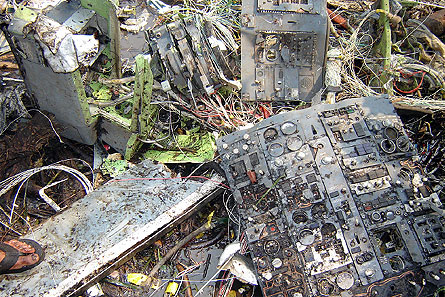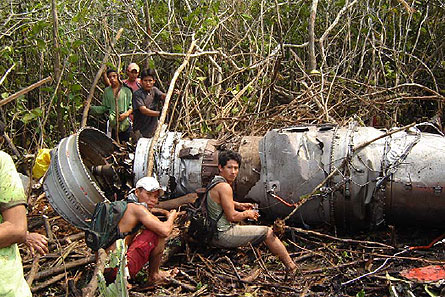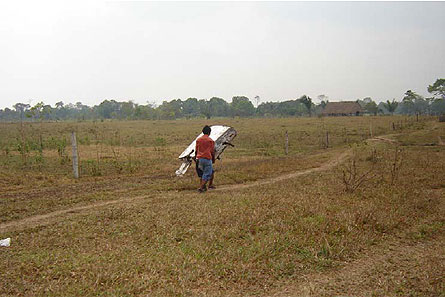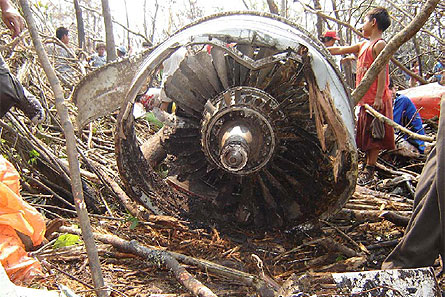By David Kaminski-Morrow in London and Rainer Uphoff in Madrid
Investigation hampered by scavengers taking wreckage including flight data recorder from crash site
Peruvian investigators have uncovered a catalogue of appalling airmanship that resulted in last August’s fatal loss of a Transportes Aéreos Nacionales de la Selva (TANS) Boeing 737-200 as it attempted to land at Pucallpa airport during a storm in August last year.
The country's government has also opted to liquidate the military-controlled civil airline, which has been grounded since January over its failure to comply with safety regulations.
Peru’s Comisión de Investigación de Accidentes e Incidentes de Aviación Civil (CIAA) attributes the crash to the crew’s decision to continue the approach, in spite of the storm, and to proceed with a non-stabilised descent. It says that a “lack of airmanship” from the crew, the absence of the assigned first officer, and a failure to adhere to standard operating procedures contributed to the crash.
CIAA’s final report into the 23 August 2005 accident heavily criticises the captain, stating: “The pilot showed too much confidence in himself while taking unnecessary risks – he committed errors of judgement and demonstrated poor planning before and during the flight.”
The report states that despite being aware of poor weather conditions, and despite the fact that unavailable runway lighting at Pucallpa meant the aircraft would have to make a visual approach, the crew decided neither to divert nor change course to avoid the storm’s nucleus.
|
|---|
|
|
|
At the time the aircraft’s captain was training a first officer whose prior experience was primarily on Soviet-era and Chinese-built turboprops, and who had just 60h on 737s. The co-pilot assigned to the flight was seated in the passenger cabin, to make way for the trainee, while a non-crew engineer was occupying the other cockpit seat.
While the pilots attempted to establish visual contact with Pucallpa’s runway 02 the aircraft descended to Flight Level 150 (1,500ft/450m) – a height of just 987ft above the ground – but was subjected to intense hail bombardment which obscured the forward view and caused the crew to lose situational awareness.
Shortly after the crew disengaged the autopilot, the 737 entered a sharp descent exceeding 1,700ft/min and struck terrain just 34s later, 3.8nm (7km) from the Pucallpa VOR, carving a 1,500m (4,900ft) swath through trees. The accident killed 35 of the 91 passengers, mainly those in the forward cabin, as well as five of the seven crew.
It adds that the crew failed to make appropriate decisions and did not appreciate the developing hazardous situation. The pilots focused their attention on trying to locate the runway, neglecting the flight and allowing the aircraft to deviate from a safe course.
CIAA’s investigation was hampered by interference from local residents who plundered the wreckage (pictured above). Authorities had to offer a $500 reward for the return of the flight-data recorder, which was subsequently found to have been too badly damaged by fire to yield any clues, and the inquiry was forced to focus on information extracted from the cockpit-voice recorder.
But conversations between the crew members revealed no evidence of technical problems with the aircraft’s Pratt & Whitney JT8D powerplants, the 737’s instruments or its flight controls.
CIAA has put forward dozens of safety recommendations to the civil aviation administration, TANS, the Peruvian airports operator and other authorities, centred on improving crew resource management, enhancing training, ensuring compliance with operating procedures, and advising installation of terrain-warning avionics and instrument landing systems.
Meanwhile the Peruvian government says it will close TANS down, stating there is no need for a costly state-funded carrier because there are other airlines operating within Peru.
"[TANS] is economically and financially non-viable as it produces a high cost load for the state,” says the government’s decree. A source at the Peruvian civil aviation administration says: “There are four private airlines which more than adequately serve Peruvian domestic routes.”
The source says that this situation “makes a state-owned airline unnecessary”. Since the grounding TANS has claimed repeatedly to be close to recovering its operations with new operations oriented towards public service to remote areas.
But the administration of Peru’s newly-elected president Alan Garcia has clearly indicated that loss-making state companies will not be maintained in sectors where private operations can meet demand.
Source: Flight International























